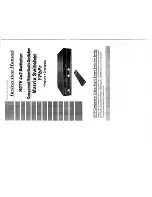
Spanning Tree
RSTP Interface Settings
Cisco Small Business SG200 Series 8-port Smart Switch
123
6
•
Port State
—Current STP state of a port. If enabled, the port state
determines the forwarding action that is taken on traffic. Possible port states
are:
-
Disabled
—STP is currently disabled on the port. The port does not
participate in the spanning tree, but is in an operational state to learn
MAC addresses and forward traffic.
-
Discarding
—Port is currently blocked and cannot be used to forward
traffic or learn MAC addresses.
-
Learning
—Port is currently in the learning mode. The port cannot
forward traffic, however, it can learn new MAC addresses.
-
Forwarding
—Port is currently in the forwarding mode. The port can
forward traffic and learn new MAC addresses.
•
Designated Bridge ID
—Bridge identifier of the bridge that offers the
lowest root path cost to a LAN. The ID is a concatenation of the bridge
priority and the base MAC address of the bridge.
•
Designated Port ID
—Port identifier on the Designated Bridge that offers
the lowest root path cost to the LAN. The ID is a concatenation of the port
priority and the interface number of the port.
•
Designated Cost
—The root path cost from the designated bridge to the
root bridge. Ports with lower designated cost are less likely to be blocked
when STP detects loops.
•
Speed
—Port speed.
•
LAG
—LAG that the port is a member of, if any.
RSTP Interface Settings
Rapid Spanning Tree Protocol (RSTP) ensures a faster convergence of a loop-free
spanning tree for any bridged LAN. To display the
RSTP Interface Settings
page,
click
Spanning Tree
>
RSTP Interface Settings
in the navigation window.
A rapid spanning tree topology is formed automatically when RSTP is selected as
the spanning tree mode. Use the
STP Status & Global Settings
page to enable
RSTP mode.
















































